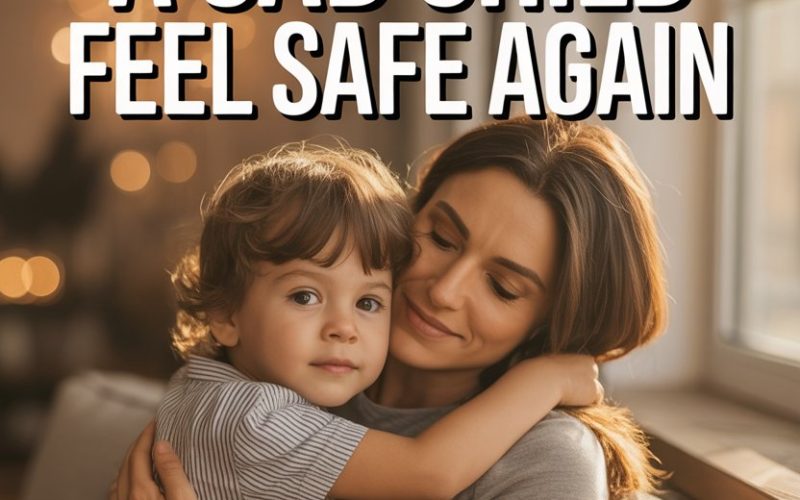A sad child can tug at a parent’s heart in ways that even the world’s finest cup of coffee can’t fix.
You want to gather those little ones up and make everything right again, but sometimes the sadness lingers, and you’re not sure how to reach them.
Life’s mishaps and big feelings seem to find children no matter how many bubble wrap layers we fantasize about. When your child’s world feels wobbly, you’re their steady lighthouse.
Here’s how you can help your child rediscover that all-important feeling of safety, even when skies are a bit grey.
Recognise the Signs Without Nagging
Children rarely stride up and announce, “I am emotionally vulnerable today, please comfort me!”
More often you’ll spot subtle changes: clinginess, silence, irritability, regressions (hello, thumb-sucking), or avoiding things they usually love.
Resist the urge to pepper them with questions or hover like a slightly anxious hummingbird. Instead, try gentle invitations to talk or sit together, leaving them space to come forward when ready.
Sometimes, just your quiet presence is reassurance enough.
Build a Predictable Routine (But Don’t Panic If You’re Not Mary Poppins)
Familiar routines can feel like a soft blanket on a rough day. Knowing what comes next helps kids feel the world isn’t entirely out of control.
This doesn’t mean your Google Calendar needs to resemble an air traffic controller’s schedule.
Even little touchstones—reading a bedtime story, Friday pizza nights, or singing the same silly song while brushing teeth—can work their quiet magic.
If life’s thrown your routines for a loop, acknowledge it. “Today’s a bit different, but we’ll have our story before bed as always.” Those constants matter.
Listen Like You Mean It
When your child wants to talk, put down the phone (yes, even if you’re halfway through a group chat about the PTA’s latest drama). Give them your full attention, even if their heartbreak is over a lost crayon or a playground “betrayal.”
Use open-ended prompts: “Tell me more about what happened,” rather than a rapid-fire quiz.
Reflect back feelings—“That sounds upsetting”—and resist the urge to leap in with fixes right away. Sometimes kids just need to know you get it.
The American Academy of Pediatrics notes that children are more likely to open up when adults listen without judgment and validate their feelings (see this summary on helping children handle big emotions).
Nodding sagely and occasionally saying “mmhmm” works wonders too.
Name the Feelings—Even the Ugly Ones
Naming the big, scary, or just plain weird feelings makes them less mysterious. You might try, “It seems like you’re feeling sad and maybe a bit nervous.”
Kids often lack the language for what’s running through their heads; helping them put words to it can shrink the monster under the bed.
Feeling “mad,” “scared,” or “jealous” is all part of the human package. The trick is letting children know that feelings are not dangerous, and they always pass.
Storybooks about emotions can help. “The Colour Monster” or “Glad Monster, Sad Monster” are favourites for younger kids, while older children might appreciate comic strips or journals.
Offer Cuddles, Hugs, and Physical Comfort
Science agrees—hugs and snuggles are more than just nice. Physical affection triggers the release of oxytocin, the “feel good” hormone, lowering stress and helping restore a sense of security (see this article for more on why hugs matter).
If your child’s not the cuddly type, sit nearby, rub their back, offer a hand to hold, or wrap them in a blanket. Sometimes being close without words is its own comfort.
Create a Safe Physical Environment
A child who’s feeling fragile may crave extra signs of safety. Soft lighting in their room, familiar objects (that scruffy teddy bear with one eye), and even a fort made of cushions can help.
Kids can feel more in control if they choose a special spot for alone time, or pick a “bravery buddy” toy to bring along during tricky moments.
If anxiety seems to be triggered by a particular space (maybe a noisy classroom, or a recently scary place), brainstorm tiny ways to make it feel safer—music, fidget toys, or a favourite jumper can all work small wonders.
Keep Reassurances Honest (But Not Overwhelming)
It’s tempting to promise, “Nothing bad will ever happen again,” but let’s face it: life has other plans.
Instead, stick to what you can control: “I’m here for you,” “You’re safe at home,” or “We’ll get through anything together.”
Reassurances land best when they’re believable and repeated gently, rather than gushed in anxious bursts.
If you’re worried about saying the wrong thing, remember: sincerity trumps perfection.
Encourage Expression Through Play and Art
Play is a child’s natural language, especially when words fail. Breaking out the crayons, Play-Doh, or a couple of superhero figurines gives your child a chance to work through feelings in a safe, pressure-free way.
Drawing how they feel, acting out scenes with toys, or even making a “worry monster” out of an old tissue box can help bring the inside out.
While it might look like a mess of scribbles to you, for your child it’s a roadmap of their emotions.
Art therapists often use creative play to help children process difficult experiences (see this overview of art therapy with children).
Model Calm and Self-Care
Children are emotional sponges. You don’t need to morph into a zen monk, but showing your own ways of coping (deep breaths, a walk around the garden, worrying out loud and then calming yourself) speaks volumes.
If you’re having a tough day, narrate it simply: “I’m feeling a bit sad, so I’m going to have a cup of tea and give myself a cuddle.”
Kids learn resilience by watching you manage feelings without imploding or stuffing them down.
Know When to Ask for Help
Finally, some sadness lingers longer or runs deeper than you can reach. If your child’s distress is severe, persistent, or affecting daily life, reaching out to your pediatrician or a child psychologist is the loving, brave move.
Signs to watch for include loss of interest in all activities, changes in sleep or appetite, withdrawal, self-harm talk, or lasting fears that don’t fade. Don’t hesitate to connect with a local support group or mental health service.
You’re not alone—many families walk this path, and support is available (see how to find a child therapist in the UK or child therapy resources in the US).
When Sadness Visits, Safety Can Return
Sadness is part of the ride, but so is healing.
Your child doesn’t need you to be all-knowing or endlessly cheerful—they just need to know you’re there, steady and warm, rain or shine.
While you can’t shield them from all of life’s bumps, your love, patience, and the occasional biscuit can make all the difference.
Safety, after all, isn’t about a perfect world. It’s about knowing someone’s got your back, even on the greyest days.





